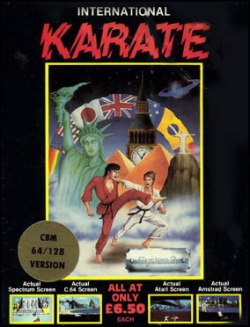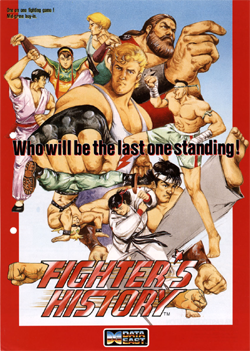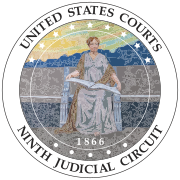The idea–expression distinction or idea–expression dichotomy is a legal doctrine in the United States that limits the scope of copyright protection by differentiating an idea from the expression or manifestation of that idea.

Epyx, Inc. was a video game developer and publisher active in the late 1970s and 1980s. The company was founded as Automated Simulations by Jim Connelly and Jon Freeman, originally using Epyx as a brand name for action-oriented games before renaming the company to match in 1983. Epyx published a long series of games through the 1980s. The company is currently owned by Bridgestone Multimedia Group Global.

Karate Champ, known in Japan as Karate Dō, is a fighting game developed by Technōs Japan and released in arcades by Data East in 1984. A variety of moves can be performed using the dual-joystick controls using a best-of-three matches format like later fighting games. The game was commercially successful, especially in the United States where it was the highest-grossing arcade game of 1985 and the best-selling home computer game up until 1989. Karate Champ established and popularized the one-on-one fighting game genre, for which it is considered one of the most influential games of all time.
A scène à faire is a scene in a book or film which is almost obligatory for a book or film in that genre. In the U.S. it also refers to a principle in copyright law in which certain elements of a creative work are held to be not protected when they are mandated by or customary to the genre.

International Karate is a fighting game developed and published by System 3 for the ZX Spectrum in 1985 and ported to various home computers over the following years. In the United States it was published by Epyx in 1986 as World Karate Championship.

A video game clone is either a video game or a video game console very similar to, or heavily inspired by, a previous popular game or console. Clones are typically made to take financial advantage of the popularity of the cloned game or system, but clones may also result from earnest attempts to create homages or expand on game mechanics from the original game. An additional motivation unique to the medium of games as software with limited compatibility, is the desire to port a simulacrum of a game to platforms that the original is unavailable for or unsatisfactorily implemented on.

Computer Associates International, Inc. v. Altai, Inc., 982 F.2d 693 is a decision from the United States Court of Appeals for the Second Circuit that addressed to what extent non-literal elements of software are protected by copyright law. The court used and recommended a three-step process called the Abstraction-Filtration-Comparison test. The case was an appeal from the United States District Court for the Eastern District of New York in which the district court found that defendant Altai's OSCAR 3.4 computer program had infringed plaintiff Computer Associates' copyrighted computer program entitled CA-SCHEDULER. The district court also found that Altai's OSCAR 3.5 program was not substantially similar to a portion of CA-SCHEDULER 7.0 called SYSTEM ADAPTER, and thus denied relief as to OSCAR 3.5. Finally, the district court concluded that Computer Associates' state law trade secret misappropriation claim against Altai was preempted by the federal Copyright Act. The appeal was heard by Judges Frank Altimari, John Daniel Mahoney, and John M. Walker, Jr. The majority opinion was written by Judge Walker. Judge Altimari concurred in part and dissented in part. The Second Circuit affirmed the district court's ruling as to copyright infringement, but vacated and remanded its holding on trade secret preemption.

Midway Manufacturing Co. v. Artic International, Inc., 704 F.2d 1009, was a legal case where the United States Court of Appeals for the Seventh Circuit found that Artic violated Midway's copyright in their arcade games Pac-Man and Galaxian. The lawsuit was part of a trend of "knock-off" video games in the early 1980s, with courts recognizing that a video game can qualify for protection as a copyrighted audiovisual work.
Analytic dissection is a concept in U.S. copyright law analysis of computer software. Analytic dissection is a tool for determining whether a work accused of copyright infringement is substantially similar to a copyright-protected work.
Substantial similarity, in US copyright law, is the standard used to determine whether a defendant has infringed the reproduction right of a copyright. The standard arises out of the recognition that the exclusive right to make copies of a work would be meaningless if copyright infringement were limited to making only exact and complete reproductions of a work. Many courts also use "substantial similarity" in place of "probative" or "striking similarity" to describe the level of similarity necessary to prove that copying has occurred. A number of tests have been devised by courts to determine substantial similarity. They may rely on expert or lay observation or both and may subjectively judge the feel of a work or critically analyze its elements.
The Abstraction-Filtration-Comparison test (AFC) is a method of identifying substantial similarity for the purposes of applying copyright law. In particular, the AFC test is used to determine whether non-literal elements of a computer program have been copied by comparing the protectable elements of two programs. The AFC test was developed by the United States Court of Appeals for the Second Circuit in 1992 in its opinion for Computer Associates Int. Inc. v. Altai Inc. It has been widely adopted by United States courts and recognized by courts outside the United States as well.

See v. Durang (1983) was a case where the author of a play claimed that another playwright had based a second play on a draft script that the plaintiff had written, infringing on its copyright. The court refused to consider the process by which the second play had been created, but chose to simply compare the end results. The court found no infringement, coining the axiom, "Copying deleted or so disguised as to be unrecognizable is not copying."

Brown Bag Software v. Symantec Corp. is an intellectual property law case in which the United States Court of Appeals for the Ninth Circuit affirmed-in-part and vacated-in-part the previous ruling of the United States District Court for the Northern District of California. Brown Bag Software sued Symantec Corporation and John L. Friend, an individual software developer for Softworks Development, for copyright infringement and several state law claims regarding the similarity of Symantec Corporation's and Brown Bag Software's computer outlining programs.
The protection of intellectual property (IP) of video games through copyright, patents, and trademarks, shares similar issues with the copyrightability of software as a relatively new area of IP law. The video game industry itself is built on the nature of reusing game concepts from prior games to create new gameplay styles but bounded by illegally direct cloning of existing games, and has made defining intellectual property protections difficult since it is not a fixed medium.

Fighter's History is a 1993 arcade fighting game developed and published by Data East. It's the inaugural game in the Fighter's History series. The main unique feature of the Fighter's History is its weak point system, which allows the player to temporarily stun an opponent by repeatedly hitting their weak point.

Tetris Holding, LLC v. Xio Interactive, Inc., 863 F.Supp.2d 394, was a 2012 American legal case related to copyright of video games, confirming that a game's look and feel can be protected under copyright law. Tetris Holding is a company that holds the copyright to the original Tetris game from 1985 and licenses those rights to game developers. Xio Interactive is a game developer that released Mino in 2009, a mobile game based on the gameplay of Tetris. Mino was downloaded millions of times, and Tetris Holding filed a DMCA notice and eventually a lawsuit against Xio for copyright infringement.

Capcom U.S.A. Inc. v. Data East Corp., 1994 WL 1751482 was a 1994 legal case related to the copyright of video games, where Capcom alleged that Data East's game Fighter's History infringed the copyright of Capcom's game Street Fighter II. It was revealed that the design documents for Fighter's History contained several references to Street Fighter II, leading Capcom to sue Data East for damages, as well as a preliminary injunction to stop the distribution of the infringing game. In spite of the intentional similarities between the two games, the court concluded that Data East did not infringe upon Capcom's copyright, as most of these similarities were not protected under copyright. Judge William H. Orrick Jr. applied a legal principle known as the merger doctrine, where courts will not grant copyright protection where it would effectively give someone a monopoly over an idea.

Spry Fox, LLC v. Lolapps, Inc., No. 2:12-cv-00147, was a court case between two video game developers, where Spry Fox alleged that the game Yeti Town, developed by 6waves Lolapps, infringed on their copyrighted game Triple Town. While the case was settled out of court, preliminary opinions by Judge Richard A. Jones affirmed that a video game's "look and feel" may be protected by copyright, affirming the federal district court decision in Tetris Holding, LLC v. Xio Interactive, Inc. from earlier the same year.

Atari, Inc. v. North American Philips Consumer Electronics Corp., 672 F.2d 607, is one of the first legal cases applying copyright law to video games, barring sales of the game K.C. Munchkin! for its similarities to Pac-Man. Atari had licensed the commercially successful arcade game Pac-Man from Namco and Midway, to produce a version for their Atari 2600 console. Around the same time, Philips created Munchkin as a similar maze-chase game, leading Atari to sue them for copyright infringement.

Atari Inc. v. Amusement World Inc., 547 F.Supp. 222 is a legal case in which the United States District Court for the District of Maryland held that Amusement World's arcade game Meteors did not violate Atari's copyright in their game Asteroids.













